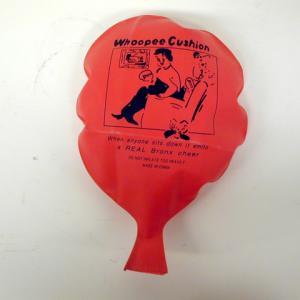College of Liberal Arts & Sciences
3B30.50 - Sound in Helium and CO2
Connect the helium tank to the organ pipes and as you fill with helium the pitch should go up. Also take a breath of helium and try to talk. Your voice pitch also goes up.
When breathing helium your vocal tract acts as a filter for the sounds produced by the vocal folds. In effect, the higher frequencies are enhanced and the intensity of the lower frequencies is lessened.
To show that the frequency does not change when replacing air with helium, use a Whoopee-Cushion. The Whoopee-Cushion will make the same sound when filled with air or helium. To simulate the vocal tract, add a plastic tube to the Whoopee-Cushion. The tone quality will change due to the resonance effect. The Whoopee-Cushion frequency that corresponds to the natural frequency of the chosen tube will be amplified
- Kyle Forinash, Cory L. Dixon, "Helium and Sulfur Hexafluroride in Musical Instruments", TPT, Vol. 52, # 8, Nov. 2014, p. 470.
- Sara Orsola Parolin, Giovanni Pezzi, "Smartphone-aided Measurements of the Speed of Sound in Different Gasesous Mixtures", TPT, Vol. 51, # 8, Nov. 2013, p. 508.
- Christopher Wentworth, "Helium Speech: An Application of Standing Waves", TPT, Vol. 49, # 4, p. 212, April 2011.
- Figuring Physics, TPT, Vol. 41, # 4, p. 245, April 2003.
- Jay S. Huebner, N. Sundaralingam, "Simple Sound Demonstration", TPT, Vol. 36, # 1, p. 16, Jan. 1998.
- Brian W. Holmes, "Whoopee-Cushion Physics", TPT, Vol. 35, # 7, Oct. 1997, p. 407.
- M. Ryan Avett, Alison Diehl, Leslie P. Scheuneman, David G. Haase, "Illusion for Motion Detectors", TPT, Vol. 35 # 1, Feb. 1997, p. 174.
- Brian Holmes, "The Helium-Filled Organ Pipe", TPT, Vol. 27, # 3, p. 218, March 1989.
- Norman F. Smith, "Bernoulli and Newton in Fluid Mechanics", TPT, Vol. 10, # 8, Nov. 1972, p. 451.
- J.K. Eddy, J. N. Fox, N. W. Gaggini, D. Ramsey, and T. Kikpatrick, "The Velocity of Sound in a Closed Tube", AJP, Vol. 55, # 12, Dec. 1987, p. 1136.
- Katie Peek, "Helium Supply", Popular Science, August 2013, p. 36.
- Borislaw Bilash II, David Maiullo, "Ringing Bells", A Demo a Day: A Year of Physics Demonstrations, p. 207.
- Julien Clinton Sprott, Physics Demonstrations, "3.3, Breathing Helium and Sulfur Hexafluoride", p. 144, ISBN 0-299-21580-6.
- 1.21, Jearl Walker, "Voice Pitch and Helium", The Flying Circus of Physics with Answers.
- Jearl Walker, "3.5, Speaking With Helium", The Flying Circus of Physics Ed. 2, p. 149.
- "151, Helium Speech", Christopher P. Jargodzki and Franklin Potter, Mad About Physics , p. 57, 200.
Disclaimer: These demonstrations are provided only for illustrative use by persons affiliated with The University of Iowa and only under the direction of a trained instructor or physicist. The University of Iowa is not responsible for demonstrations performed by those using their own equipment or who choose to use this reference material for their own purpose. The demonstrations included here are within the public domain and can be found in materials contained in libraries, bookstores, and through electronic sources. Performing all or any portion of any of these demonstrations, with or without revisions not depicted here entails inherent risks. These risks include, without limitation, bodily injury (and possibly death), including risks to health that may be temporary or permanent and that may exacerbate a pre-existing medical condition; and property loss or damage. Anyone performing any part of these demonstrations, even with revisions, knowingly and voluntarily assumes all risks associated with them.

